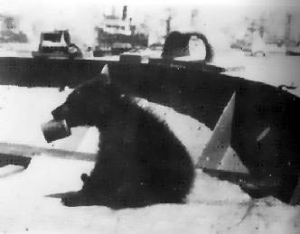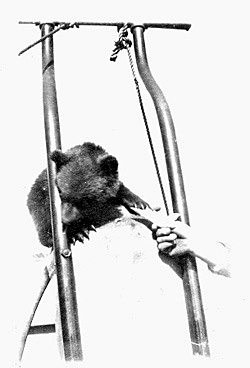Bear With Us
Sailors love souvenirs from foreign parts, usually trinkets and keepsakes for family and friends.

“Bruno” (aka “Haca-Daddy”), was adopted in northern Japan by the crew of HMCS THIEPVAL and brought to Naden in 1924.
But when the crew of HMCS THIEPVAL returned to Esquimalt in 1924, they brought with them a living reminder of their travels, a higuma (brown bear) from the northern island of Hokkaido, Japan.
The bear was acquired in Hakodate, the port where THIEPVAL and her crew sojourned for two months on their way home to Esquimalt. Those months represented the last leg of a precarious journey filled with setbacks, a journey that took THIEPVAL 10,000 miles in search of old-fashioned adventure. For a full account of THIEPVAL’s journey, you can read Frederick Watt’s story of the trip here – Ten Thousand Miles on the THIEPVAL
In her role as support vessel to a round-the-world flight attempt by Major Stuart MacLaren, she battled rough seas and weather, and desperate shortages of fuel, food, and water. So the stopover in Hakodate came as a welcome rest for the little grey minesweeper’s beleaguered crew. When THIEPVAL dropped anchor in Hakodate harbour, there wasn’t a drop of fresh water aboard, and only enough coal in the bunkers for another hour of steam-powered travel, at best.
While they waited out delays in MacLaren’s flight, the crew re-fuelled, repaired and re-stocked the ship. In their spare time, they played football with their Japanese hosts, enjoyed the countryside, and befriended the bear, named “Bruno” (another nickname that later stuck to the well-travelled bear was “Haca-Daddy”, a version of Hakodate).
The small bear was already semi-tame, and the men grew so attached to it that they decided to adopt the animal, which is how a higuma from Hokkaido came to be at Naden.
(Joan Williamson, whose father served in THIEPVAL during this period, recollects that there were two bears aboard on the journey back to Esquimalt, but only one of the pair survived.
According to the recollections of Mrs. Willamson, “…one was a small bear and one bear was a big bear, but when they got them they were cubs. This cub felt the cold when they were coming back, it felt the cold so badly. Dad said it could get in behind the boilers and it was warm, lovely. But it was getting quite big, they fed it of course, and it was also getting quite rough. So it got behind the boiler, I guess it squeezed itself in and then couldn’t get out, and they had to shoot it. “)
Life in Esquimalt may not have brought much happiness to Bruno. To modern ears, the sailors’ treatment of the bear sounds inhumane. They gave it gin, for which it developed a taste, so much so that it became part of wardroom routine to serve Bruno a daily tot when the bugle call sounded for ‘Up Spirits’.
Failure to provide the expected ration of gin could result in a cranky bear appearing at the Quartermaster’s office. These antics were a source of amusement for the men stationed at Naden, who built a tree house near the parade square to house it.
Sometimes members of the ship’s company took the bear, on a chain, out drinking with them to the local taverns. Thus escorted, the sailors never had trouble finding a seat or getting service, even in the busiest drinking spot.
The Naden bear reportedly came to a sad end. Bruno ate a combination of caustic soda and soap, and died, to be mourned by the crew of HMCS THIEPVAL.
(Mr. George Wilkinson, who as a boy spent many happy hours playing in and around Naden while his father was employed in the Royal Naval College of Canada, and then later in the Naval Magazine on Cole Island, has a different remembrance of the bear’s demise.
Mr. Wilkinson recalls that “we also played with Bruno the bear brought in from Asia by THIEPVAL. The story we were given about its death was that it received burns in the engine room of one of the ships, not from ingesting caustic soda.”)
By Clare Sharpe
Museum staff member/webmaster

 CFB Esquimalt Naval and Military Museum
CFB Esquimalt Naval and Military Museum CFB Esquimalt Naval and Military Museum
CFB Esquimalt Naval and Military Museum CFB Esquimalt Naval and Military Museum
CFB Esquimalt Naval and Military Museum CFB Esquimalt Naval and Military Museum
CFB Esquimalt Naval and Military Museum CFB Esquimalt Naval and Military Museum
CFB Esquimalt Naval and Military Museum CFB Esquimalt Naval and Military Museum
CFB Esquimalt Naval and Military Museum CFB Esquimalt Naval and Military Museum
CFB Esquimalt Naval and Military Museum CFB Esquimalt Naval and Military Museum
CFB Esquimalt Naval and Military Museum CFB Esquimalt Naval and Military Museum
CFB Esquimalt Naval and Military Museum